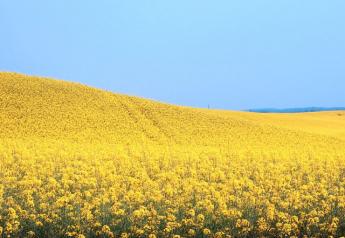Grasshoppers Swarm Wheat Fields, A Phenomenon One Grower Hasn't Seen Since the 1980s
AgDay 07/16/21 - Montana Drought
Montana farmers are dealing with a double dose of weather issues. The lack of rain has been showing up on the U.S. Drought Monitor all year, with shades of orange and red painted across the entire state.

In addition to the extreme dryness plaguing fields, the extreme heat is also suffocating crops in parts of the state. While some areas of Montana had rain and cooler temperatures last week, the historic heat is back on deck, with forecasts showing temperatures topping 100 degrees °F.
?We hit 100 degrees here in Glasgow today. This is the 7th day in 2021 with a high >=100.
?And highs will be >=100 in Glasgow everyday for at least the next week.
?The year with the most highs >=100 was 1936, checking in with 22 days. #mtwx #heatwave2021 — NWS Glasgow (@NWSGlasgow) July 16, 2021
For Montana farmers, some took a chance on planting early, while others waited on a rain to plant. When the rains never came, the later-planted spring wheat crops crumpled and are what's struggling the most in Montana right now.
"The extreme heat isn't typical, at least not this extreme," says Terry Angvick, a farmer in Sheridan County, Mont. "I mean, we will normally have hot days in July and August, sure, but nothing like this. Usually when we have hot temperatures like this, they bring thunderstorms. We haven't seen that very much."
Between the later-planted crops already shriveling up from lack of moisture, he says the heat next week will be lethal for the portion of the crop that's already barely hanging on.
"We have several fields here that are in tough shape, and it's a combination of things," Angvick says. "We have poor stands because of the drought, so thin, poor emergence, and then along with being planted later and lack of moisture, we have a poor stand in wheat to begin with. So with the grasshoppers coming along, that'll kind of just finish it off. That's probably a tough way to say that, but that's kind of what happens."
Grasshoppers Preying on Dry Wheat Fields
Yes, grasshoppers. Intense swarms of grasshoppers are even showing up on this National Weather Service graphic, an issue Angvick hasn't seen this extreme since the 1980s.
"They were really bad in the mid-80s for about three years in a row," he says. "Dry conditions, dry fall conditions, equal some great survival of insects like grasshoppers."

This pictures shows the damage grasshoppers can cause. Taken in a Montana spring wheat field this week, the pests start in the ditch, moving their way into the corners and edges of a field.
Angvick says the grasshoppers are showing up in pockets around his Montana county, but once grasshoppers are mobile, they are almost too late to control.
"Once they start flying, now they're mobile, and when you said something about the radar, that's exactly what happens. They become very mobile in a case like that."
Growers in his area are doing everything they can, including spraying insecticide for more than three weeks straight. But as conditions grow even more dire, the grasshoppers prey on those fields, making conditions even worse.
"They will reduce the crop in fields significantly to the point where in some there will be no harvest," he says. "First thing they'll do is strip the leaves off the plants. And then if it hasn't headed yet, I'm thinking in terms of wheat, then the next thing the grasshoppers do is they'll crawl up and clip the [wheat] head off."
Angick says in the earlier planted wheat crop, that is in better shape with more vegetation, the grasshoppers didn't consume those fields as much. It's the fields that look the worst, and are drying up, to which the grasshoppers are attracted. Angvick estimates up to 50% of the wheat in his area was planted late.
"The average crop in this area is about 35 bushels of spring wheat or Durham, and this year will be around 30% to maybe 40% of that," he adds. "So, 10- to 15-bushel an acre average in the county. And that might be optimistic."
It's not just Montana seeing extensive damage from grasshoppers preying on fields. Utah Wool Growers Association shared the following pictures with AgDay, showing the combination of drought, heat and grasshopper infestation.

Grasshoppers Popping Up in Texas
According to AgFax's Southwest Cotton newsletter, the grasshoppers are also showing up in Texas.
“Insects are not a big issue, but we’re seeing a few grasshoppers in irrigation circle corners," says Tim Ballinger, Ballinger Innovative Agronomics, Dumas, Texas. "We’ll need to keep scouting for these and other insects that can attack our fields."
The grasshoppers aren't destroying Texas fields like they are in Montana. Ballinger says the reason is the Texas Panhandle has seen rains, with more than an inch falling again last week.
“On other crops, corn is healthy and enjoyed the rain. It’s tasseling, putting on ears and silking. It’s approaching peak water use, so guys need to manage their irrigation schedule closely after all of the rain. Sorghum is all over the board. Some is 2 leaf to 3 leaf, while other fields are at 12 leaf to 13 leaf and will be booting in about two weeks," Ballinger says.
He says the late spring and early summer rains helped the winter wheat crop in his area. Wheat harvest produced an above-average crop in his area, with yields anywhere from 70 bushels to 100 bushels per acre.
"The May rains benefited the wheat,” he says.







